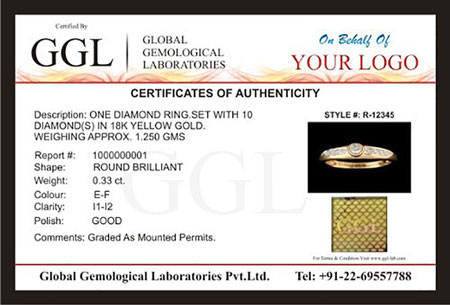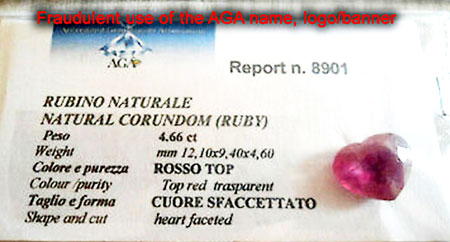 Fraud Alert!
Fraud Alert!
Fake Lab Reports
Late last year, just before the holidays, AGA sent out an industry-wide fraud alert: Its name and logo were being attached to bogus lab reports.
AGA, the Accredited Gemologists Association, is not a lab and does not provide gem grading services.
The name sounds impressive, though, with "gemologist" in the title. Scammers count on the public being easily fooled. And why bother to even make up a name for your non-existent lab, when you can easily lift a logo from the Web and print up some docs that look official?
In this case consumers could readily discover the hoax if they tried to check the report number. Perhaps some did so, and that's how the bogus reports came to the attention of AGA. But it's very likely other consumers took the documents at face value, thinking they provided some "independent validation" of the seller's claims. In reality, these docs are worthless; the quality of the stones could be anything.
Craze for "certified" gems
Consumers tend to regard the paper that accompanies a "certified" gem as a guarantee of high quality. It's not.
A lab report—from a reputable grading lab—accurately describes the gem, of whatever quality it may be; such a lab report is a useful document to both consumer and insurer. But not every "cert" is a report from a reliable lab.
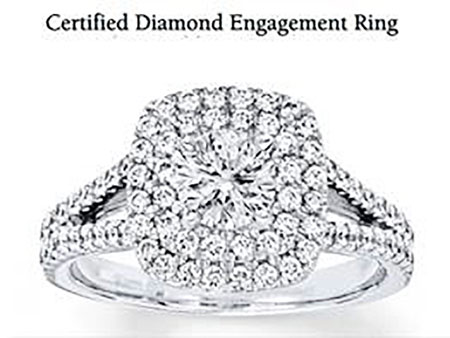 Offering "certified" gems is an important sales strategy for retailers, and innumerable labs have sprung up to feed the need. Labs with questionable reputations, and some completely bogus labs (and businesses that don't even identify themselves as labs), produce documents meant to look independent and unbiased, but are designed merely to impress.
Offering "certified" gems is an important sales strategy for retailers, and innumerable labs have sprung up to feed the need. Labs with questionable reputations, and some completely bogus labs (and businesses that don't even identify themselves as labs), produce documents meant to look independent and unbiased, but are designed merely to impress.
Bogus lab reports may be called Gem Report, Gem Description, Appraisal Report, Official Gem ID Card, Diamond Certificate, Assurance of Excellence, Certificate of Authenticity, Gem Identify Card, Diamond Data Card—or any number of other names.
Disreputable labs are support systems for untrustworthy jewelry sellers.
We cannot name the labs that are untrustworthy, nor do we have the means to test them all. A few years ago there were estimated to be over 80 gem-grading labs. That number has no doubt increased worldwide, as have scams such as the one at the head of this story. What we can do is recommend the good ones, the labs with a history of accuracy.
Reliable labs are listed below. But first, let's look at the extent of the problem.
Consumers have been stung
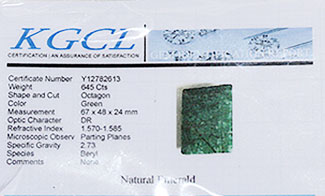 Discussion sites on the internet are full of anger, frustration and disappointment over unethical practices and blatant rip-offs.
Discussion sites on the internet are full of anger, frustration and disappointment over unethical practices and blatant rip-offs.
This KGCL cert verifies a stone as "natural emerald" of 645 carats (!), but it turned out to be cheap colorless beryl injected with green dye.
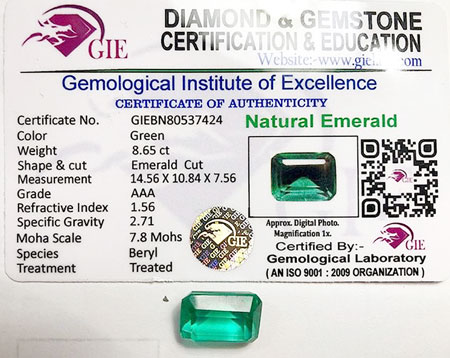 "I tried very hard to find information on the Geological Institute of Excellence. There were several Internet hits, which were all positive reviews, but as I looked into them, they were all published by the company itself. "
"I tried very hard to find information on the Geological Institute of Excellence. There were several Internet hits, which were all positive reviews, but as I looked into them, they were all published by the company itself. "
"They also sell FAKE (glass) sapphires——BEWARE"
 The card is from Gemstones Testing Laboratory of India. It has no contact information and no website presence. Perhaps the consumer purchased the stone while travelling.
The card is from Gemstones Testing Laboratory of India. It has no contact information and no website presence. Perhaps the consumer purchased the stone while travelling.
A subsequent appraisal found the stone to be topaz, a much less expensive gem than the sapphire declared on the report. And the stone was dyed to achieve its color.
 This colorful laminated card for "natural emerald" came with a 34-carat piece of "fractured quartz that was literally dripping green oily dye."
This colorful laminated card for "natural emerald" came with a 34-carat piece of "fractured quartz that was literally dripping green oily dye."
Also of interest:
On this certificate, GGL website address is for Global Gems Lab. In the example below, GGL stands for Gurgaon Gem Lab.
The consumer who bought this stone, identified as sapphire, checked the report number online and found a completely different gem described. So much for this lab's report-check feature.
Note also the two asterisks in lower left corner.
- "Image may be enhanced or approximate." This means the picture does not show the stone described. The only point of the image is to make the report look pretty.
- "As given by supplier" This means no appraiser at GGL looked at the stone. The gem's description is based on what the gem supplier said.
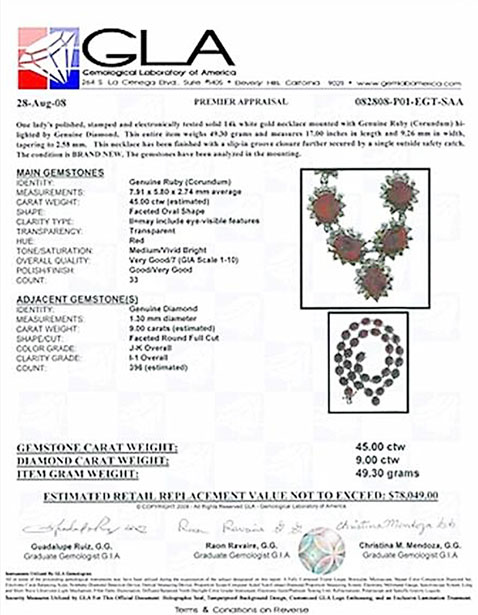 One consumer, after taking responsibility for an ailing family member, found her recently purchased jewelry with GLA appraisals estimating the value of those items at nearly $200,000. A close look at the relative's bank account showed that she had paid about $1000 for the lot.
One consumer, after taking responsibility for an ailing family member, found her recently purchased jewelry with GLA appraisals estimating the value of those items at nearly $200,000. A close look at the relative's bank account showed that she had paid about $1000 for the lot.
She probably got her money's worth, but what about those valuations?! Notice, in this sample "Premier Appraisal" from GLA's website, the line just above the appraisers' signatures. It says: "Estimated retail replacement value not to exceed: $78,049.00" Easy to agree that even a true value of $20 would not exceed $78,049.
As more than one contributor warned, sometimes in all caps: "GLA is not GIA."
Just how bad are bad lab reports?
- They may fail to disclose gem treatments, such as dying and fracture-filling, which make the gem temporarily appear better than it is.
- They may fail to mention that the stone is poorly cut or heavily included.
- They may identify the stone as a gem of value when it is really a low-quality material – or even glass. They may describe it as "natural" just because that word sounds good to the consumer.
- They may exaggerate a gem's qualities, to justify a high price.
- They may even assign an unjustifiably high value to the stone — when valuation, which depends on the current market, is not the job of a grading lab but of an appraiser.
- Some "lab reports" even carry the retailer's logo. Valuation and the seller's logo are sure signs that the provider of the report is not independent of the seller. The gem description and valuation are merely parroting information given by the client, the retailer.
- They may be mass produced for a retailer, to accompany stones that have never been viewed by an appraiser.
- One consumer found a faceted ruby valued by a lab at $20,000, which a later appraisal put at $750. His comment: "I wonder whose interests the lab represents? Being a cynic I reckon it's likely the insurance companies who must make huge premiums off people who have had such valuations. I'd be intrigued to know if anyone has ever claimed and been paid out based on [such an inflated] valuation."
That last comment has many tentacles:
"I wonder whose interests the lab represents?" This may be a "lab" that represents the interest of the retailer, by supplying what appear to be independent "lab reports," but are really sales pieces designed to impress and hoodwink the customer.
"It's likely the insurance companies who must make huge premiums off people who have had such valuations."Such grossly exaggerated valuations create serious moral hazard, which runs rampant in jewelry insurance. Far from wanting to make huge premiums on inflated valuations, insurers must be on guard against fraudulent valuations.
"If anyone has ever claimed and been paid out based on [such an inflated] valuation." This could indeed happen, as some insurers will accept an appraisal at face value. Later, when the customer finds out the true value of their purchase, they may decide to "lose" the jewelry and file a claim. We recommend always asking for the sales receipt, as the actual price paid is likely to be a reasonable indication of market value. Of course, we also recommend a report from a reliable grading lab.
Reliable Labs
All high-value jewelry should have a grading report from a respected lab. We recommend the following labs, and you can use these links to check the authenticity of reports that you receive.
Gemological Institute of America GIA Report Check
American Gem Society Lab AGS Report Verification
Gem Certification and Assurance Lab GCAL Certificate Search
FOR AGENTS & UNDERWRITERS
Names of reliable grading labs, unreliable labs, and completely bogus labs can sound much alike, and their initials are even more confusing. Documents may look official and have a lot of information, but that doesn't mean the info is accurate.
We cannot stress enough: A lab report is only as good as the lab that issues it.
Rely only on reports from labs that are known and respected for their accuracy, such as those listed above. Check the report number on the lab's website.
Be especially cautious about appraisals and other documents that accompany jewelry purchased abroad. Tourists love to purchase jewelry on their trips, especially in resort destinations and cruise ship ports. While there are some trustworthy businesses, there also are many scammers selling imitation or highly treated stones worth a tiny fraction of their purchase price. See Vacation Jewelry – Insurers Beware!
Be cautious about jewelry purchased online. One consumer commented: "I found an online forum with some absurdly good deals. They offer a certificate by KGCL that looks a bit sketchy, because a google search turns up nothing for the company. Maybe KGCL is a company in India that is deep in the mines, and has no time for a website? If so then it could be true, and a very good deal." Hope springs eternal, as does gullibility.
All scheduled jewelry, even jewelry with a lab report, should have an appraisal from a reliable and trained gemologist appraiser who is independent of the seller.
The best appraisal includes the JISO 78/79 appraisal form and is written by a qualified gemologist (GG, FGA+, or equivalent), preferably one who has additional insurance appraisal training. One course offering such additional training is the Certified Insurance Appraiser™ (CIA) course of the Jewelry Insurance Appraisal Institute.
FOR ADJUSTERS
Be on guard against moral hazard, as inflated valuations of jewelry are rampant and bogus labs abound. The incidents cited in the story above are only the tip of the iceberg.
Compare appraised value with the sales receipt. If the appraisal valuation is significantly higher, the actual purchase price is a better indication of value. If there is no sales receipt on file, ask the insured for it.
On a damage claim, ALWAYS have the jewelry examined in a gem lab that has reasonable equipment for the job and is operated by a trained gemologist (GG, FGA+ or equivalent), preferably one who has additional insurance appraisal training, such as a Certified Insurance Appraiser™. Such an exam can verify that information on the appraisal is true, and that the condition of the gem is not due to inherent vice.
©2000-2025, JCRS Inland Marine Solutions, Inc. All Rights Reserved. www.jcrs.com

